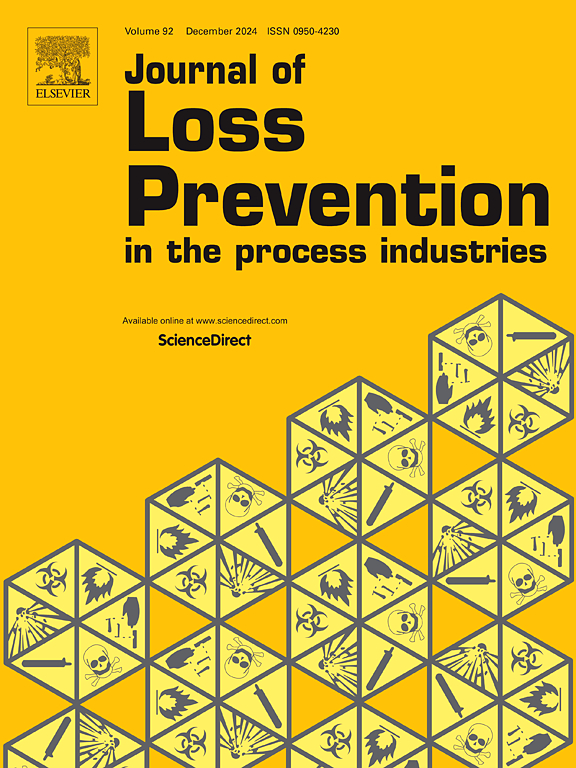Experimental study on the influence of three typical surfactants on the explosion characteristics of coal dust clouds
IF 4.2
3区 工程技术
Q2 ENGINEERING, CHEMICAL
Journal of Loss Prevention in The Process Industries
Pub Date : 2025-06-17
DOI:10.1016/j.jlp.2025.105716
引用次数: 0
Abstract
The extensive application of surfactants in wet dust removal technology may alter the combustion and explosion risk characteristics of coal dust. This is of great engineering significance for the safety prevention and control in the process industry. To assess the impact mechanism of surfactant treatment on the safety parameters of dust explosion, this study selected three typical surfactants (SDS, Triton™ X 100, and CTAB) and systematically investigated the evolution rules of the explosion hazards of coal dusts with different degrees of coalification (lignite, bituminous coal, anthracite).Using a 20-L explosion chamber, the explosion parameters (Pmax, (dP/dt)max) were measured. The thermodynamic behavior and functional group evolution were analyzed by integrating TG/DTG-DSC and FTIR techniques. The study revealed that the regulation of explosion intensity by surfactants is coal rank dependent. Specifically, SDS treatment significantly enhanced the explosion pressure of lignite (with a 13.0 % increase in Pmax) while inhibiting the explosion reaction of anthracite. Triton™ X-100 generally reduced the explosion risk but exhibited coal-ank sensitivity (the inhibition efficiency of lignite was merely 18.7 % of that of anthracite).Mechanistic studies indicate that surfactants alter the reaction pathway by regulating the key active sites (hydroxyl/oxygen-containing functional groups) of coal-oxygen recombination. Hydroxyl groups play a dominant role in the explosion-enhancing effect of low-rank coal, while the explosion inhibition of high-rank coal is associated with the recombination of oxygen-containing groups. This research uncovers the dual-safety effects of surfactants in the dust-removal process and offers a theoretical foundation for the risk-graded prevention and control of wet dust-suppression systems in the process industry.
三种典型表面活性剂对煤尘云爆炸特性影响的实验研究
表面活性剂在湿式除尘技术中的广泛应用可能会改变煤尘的燃烧和爆炸危险特性。这对过程工业的安全防控具有重要的工程意义。为评价表面活性剂处理对粉尘爆炸安全参数的影响机理,本研究选取了3种典型表面活性剂(SDS、Triton™X 100和CTAB),系统研究了不同煤化程度(褐煤、烟煤、无烟煤)煤尘爆炸危险性的演化规律。使用20 l的爆炸室,测量了爆炸参数(Pmax, (dP/dt)max)。采用热重/DTG-DSC和红外光谱(FTIR)技术对其热力学行为和官能团演化进行了分析。研究表明,表面活性剂对爆炸强度的调节与煤的煤阶有关。SDS处理显著提高了褐煤的爆炸压力(Pmax增加13.0%),抑制了无烟煤的爆炸反应。Triton™X-100总体上降低了爆炸风险,但表现出煤库敏感性(褐煤的抑制效率仅为无烟煤的18.7%)。机理研究表明,表面活性剂通过调节煤氧复合的关键活性位点(羟基/含氧官能团)来改变反应途径。低阶煤的增爆作用以羟基为主,高阶煤的抑爆作用与含氧基团的重组有关。本研究揭示了表面活性剂在除尘过程中的双重安全效应,为过程工业湿式抑尘系统的风险分级防控提供了理论依据。
本文章由计算机程序翻译,如有差异,请以英文原文为准。
求助全文
约1分钟内获得全文
求助全文
来源期刊
CiteScore
7.20
自引率
14.30%
发文量
226
审稿时长
52 days
期刊介绍:
The broad scope of the journal is process safety. Process safety is defined as the prevention and mitigation of process-related injuries and damage arising from process incidents involving fire, explosion and toxic release. Such undesired events occur in the process industries during the use, storage, manufacture, handling, and transportation of highly hazardous chemicals.

 求助内容:
求助内容: 应助结果提醒方式:
应助结果提醒方式:


